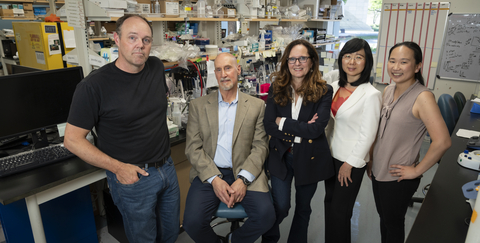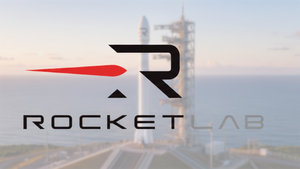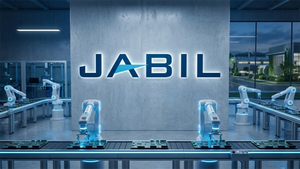The laboratory builds upon City of Hope’s legacy of stem cell innovations, including its leading bone marrow/stem cell transplant program and cancer immunotherapy research
City of Hope®, one of the largest cancer research and treatment organizations in the United States, has been awarded $5.4 million from the California Institute for Regenerative Medicine (CIRM) to build and fund a stem cell research laboratory on its Duarte, California, campus that will further expand its scientific capabilities.
This press release features multimedia. View the full release here: https://www.businesswire.com/news/home/20240520952331/en/

From left to right the laboratory team includes Mark LaBarge, Ph.D., professor of population sciences; John Termini, Ph.D., professor of cancer biology and molecular medicine; Nadia Carlesso, Ph.D., chair of stem cell biology and regenerative medicine; Yanhong Shi, Ph.D., chair of neurodegenerative diseases and Herbert Horvitz Professor in Neuroscience; June-Wha Rhee, M.D., assistant professor of cardiology. Not pictured is Michael Barish, Ph.D., professor of stem cell biology and regenerative medicine. (Photo: City of Hope)
The mission of the unique Stem Cell-Based Disease Modeling Laboratory is two-fold. First, it will advance stem cell-based disease modeling to spur innovation in regenerative medicine. The laboratory leverages City of Hope’s infrastructure and expertise using human cell-derived organoids — a key focus in current efforts to create disease models relevant to understanding biological mechanisms that often lead to new therapies. In particular, the laboratory will supply healthy and cancerous stem cell-based models in brain, heart and breast tissue to the region’s scientists for research.
Second, it will stimulate stem cell research in medically underserved communities by increasing scientists’ access to specialized laboratory equipment services, and training and by educating students about regenerative medicine.
“Our new laboratory will expand access to state-of-the-art disease models to researchers at City of Hope and our neighboring institutions, enabling them to pursue impactful scientific questions and to accelerate innovation in stem cell therapies,” said program director Nadia Carlesso, Ph.D., City of Hope’s chair of stem cell biology and regenerative medicine. “This will accelerate research in regenerative medicine, benefiting patients and researchers throughout California. We also aim to plant the seed for future careers in regenerative medicine by educating students about the field.”
Carlesso’s team will focus on Southern California regions, such as the Inland Empire, which is home to some of the fastest growing, low-income communities that face greater health issues and have access to fewer physicians.
“It is important to emphasize that innovative biomedical research flourishes when people with different perspectives, experience and skills are empowered to explore new ideas and to work collaboratively and inclusively,” Carlesso said. “Thus, recruiting, training, retaining and nurturing a workforce representing all dimensions of diversity is critical for the development and implementation of leading-edge therapies that can reach underserved populations.”
To this end, a 22-person educational team will educate community physicians, researchers and students on how to use stem cell disease models with the goal of cultivating California’s future workforce in regenerative medicine. These programs will partner with higher education institutes in the Inland Empire and with K‑12 school districts in Duarte, Monrovia, Charter Oak and Azusa, as well as provide hands-on training to undergraduate/graduate students, postdoctoral fellows, researchers and others.
“We are eager to introduce more people to the exciting world of stem cell research and shape their vision for future jobs in science,” said co-program director John Termini, Ph.D., professor of cancer biology and molecular medicine at City of Hope. “Our workshops will explore how to apply the field’s techniques and examine diverse approaches to solving medical problems.”
“Long-term activities supported by the laboratory will accelerate research in regenerative medicine, benefiting patients and researchers throughout California,” said Carlesso, who is also associate director of basic research at the Gehr Family Center for Leukemia Research at Beckman Research Institute of City of Hope.
Led by Carlesso and Termini, the laboratory team includes Michael Barish, Ph.D., professor of stem cell biology and regenerative medicine; Mark LaBarge, Ph.D., professor of population sciences; June-Wha Rhee, M.D., assistant professor of cardiology; and Yanhong Shi, Ph.D., chair of neurodegenerative diseases and Herbert Horvitz Professor in Neuroscience.
The grant to Carlesso’s team adds to the more than $212 million that Beckman Research Institute at City of Hope has received from CIRM to date, indicating the state-funded agency’s support of City of Hope’s long-standing leadership in stem cell-related therapies.
As a biomedical institution, City of Hope holds deep expertise in developmental and stem cell biology, resulting in strong clinical programs in bone marrow transplantation, cancer immunotherapy and gene therapy research to correct genetic defects, as well as cell replacement and tissue regeneration strategies to potentially treat diabetes.
The Stem Cell-Based Disease Modeling Laboratory will operate in a renovated space that will assemble state-of-the-art instruments and technologies and centralize the generation and establishment of organoid models. It joins a wealth of City of Hope core resources, including Biostatistics & Mathematical Oncology and Gene Editing and Viral Vector cores, to both advance science and train others in subspecialized scientific areas.
About City of Hope
City of Hope's mission is to make hope a reality for all touched by cancer and diabetes. Founded in 1913, City of Hope has grown into one of the largest cancer research and treatment organizations in the U.S. and one of the leading research centers for diabetes and other life-threatening illnesses. City of Hope research has been the basis for numerous breakthrough cancer medicines, as well as human synthetic insulin and monoclonal antibodies. With an independent, National Cancer Institute-designated comprehensive cancer center at its core, City of Hope brings a uniquely integrated model to patients spanning cancer care, research and development, academics and training, and innovation initiatives. City of Hope’s growing national system includes its Los Angeles campus, a network of clinical care locations across Southern California, a new cancer center in Orange County, California, and cancer treatment centers and outpatient facilities in the Atlanta, Chicago and Phoenix areas. City of Hope’s affiliated group of organizations includes Translational Genomics Research Institute and AccessHopeTM. For more information about City of Hope, follow us on Facebook, X, YouTube, Instagram and LinkedIn.
View source version on businesswire.com: https://www.businesswire.com/news/home/20240520952331/en/
Contacts
Letisia Marquez
lemarquez@coh.org
626-476-7593






